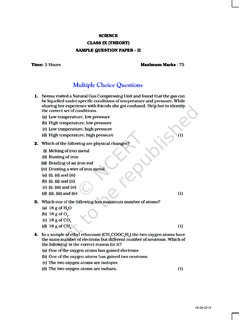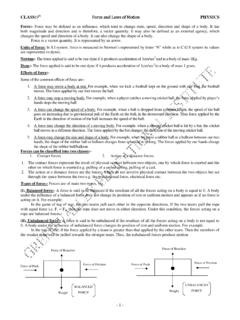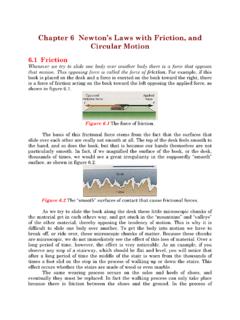Transcription of LAWS OF MOTION - National Council of …
1 CHAPTER FIVELAWS OF INTRODUCTIONIn the preceding Chapter, our concern was to describe themotion of a particle in space quantitatively. We saw thatuniform MOTION needs the concept of velocity alone whereasnon-uniform MOTION requires the concept of acceleration inaddition. So far, we have not asked the question as to whatgoverns the MOTION of bodies. In this chapter, we turn to thisbasic us first guess the answer based on our commonexperience. To move a football at rest, someone must kick throw a stone upwards, one has to give it an upwardpush. A breeze causes the branches of a tree to swing; astrong wind can even move heavy objects. A boat moves in aflowing river without anyone rowing it. Clearly, some externalagency is needed to provide force to move a body from , an external force is needed also to retard or stopmotion.
2 You can stop a ball rolling down an inclined plane byapplying a force against the direction of its these examples, the external agency of force (hands,wind, stream, etc) is in contact with the object. This is notalways necessary. A stone released from the top of a buildingaccelerates downward due to the gravitational pull of theearth. A bar magnet can attract an iron nail from a shows that external agencies ( gravitational andmagnetic forces ) can exert force on a body even from short, a force is required to put a stationary body inmotion or stop a moving body, and some external agency isneeded to provide this force. The external agency may or maynot be in contact with the far so good. But what if a body is moving uniformly ( skater moving straight with constant speed on a horizontalice slab) ?
3 Is an external force required to keep a body inuniform MOTION ? s law of s first law of s second law s third law of of of a forces in problems inmechanicsSummaryPoints to ponderExercisesAdditional ARISTOTLE S FALLACYThe question posed above appears to be , it took ages to answer it. Indeed, thecorrect answer to this question given by Galileoin the seventeenth century was the foundationof Newtonian mechanics, which signalled thebirth of modern Greek thinker, Aristotle (384 ), held the view that if a body is moving,something external is required to keep it to this view, for example, an arrowshot from a bow keeps flying since the air behindthe arrow keeps pushing it. The view was part ofan elaborate framework of ideas developed byAristotle on the MOTION of bodies in the of the Aristotelian ideas on MOTION are nowknown to be wrong and need not concern our purpose here, the Aristotelian law ofmotion may be phrased thus: An external forceis required to keep a body in law of MOTION is flawed, as we shallsee.
4 However, it is a natural view that anyonewould hold from common experience. Even asmall child playing with a simple (non-electric)toy-car on a floor knows intuitively that it needsto constantly drag the string attached to the toy-car with some force to keep it going. If it releasesthe string, it comes to rest. This experience iscommon to most terrestrial MOTION . Externalforces seem to be needed to keep bodies inmotion. Left to themselves, all bodies eventuallycome to is the flaw in Aristotle s argument? Theanswer is: a moving toy car comes to rest becausethe external force of friction on the car by the flooropposes its MOTION . To counter this force, the childhas to apply an external force on the car in thedirection of MOTION . When the car is in uniformmotion, there is no net external force acting on it:the force by the child cancels the force ( friction)by the floor.
5 The corollary is: if there were no friction,the child would not be required to apply any forceto keep the toy car in uniform opposing forces such as friction (solids)and viscous forces (for fluids) are always presentin the natural world. This explains why forcesby external agencies are necessary to overcomethe frictional forces to keep bodies in uniformmotion. Now we understand where Aristotlewent wrong. He coded this practical experiencein the form of a basic argument. To get at thetrue law of nature for forces and MOTION , one hasto imagine a world in which uniform MOTION ispossible with no frictional forces opposing. Thisis what Galileo THE LAW OF INERTIAG alileo studied MOTION of objects on an inclinedplane. Objects (i) moving down an inclined planeaccelerate, while those (ii) moving up retard.
6 (iii) MOTION on a horizontal plane is anintermediate situation. Galileo concluded thatan object moving on a frictionless horizontalplane must neither have acceleration norretardation, it should move with constantvelocity (Fig. (a)).(i)(ii)(iii)Fig. (a)Another experiment by Galileo leading to thesame conclusion involves a double inclined ball released from rest on one of the planes rollsdown and climbs up the other. If the planes aresmooth, the final height of the ball is nearly thesame as the initial height (a little less but nevergreater). In the ideal situation, when friction isabsent, the final height of the ball is the sameas its initial the slope of the second plane is decreasedand the experiment repeated, the ball will stillreach the same height, but in doing so, it willtravel a longer distance.
7 In the limiting case, whenthe slope of the second plane is zero ( is ahorizontal) the ball travels an infinite other words, its MOTION never ceases. This is,of course, an idealised situation (Fig. (b)).Fig. (b)The law of inertia was inferred by Galileofrom observations of MOTION of a ball on adouble inclined OF MOTION91In practice, the ball does come to a stop aftermoving a finite distance on the horizontal plane,because of the opposing force of friction whichcan never be totally eliminated. However, if therewere no friction, the ball would continue to movewith a constant velocity on the horizontal thus, arrived at a new insight onmotion that had eluded Aristotle and those whofollowed him. The state of rest and the state ofuniform linear MOTION ( MOTION with constantvelocity) are equivalent.
8 In both cases, there isno net force acting on the body. It is incorrect toassume that a net force is needed to keep a bodyin uniform MOTION . To maintain a body inuniform MOTION , we need to apply an externalforce to ecounter the frictional force, so thatthe two forces sum up to zero net summarise, if the net external force is zero,a body at rest continues to remain at rest and abody in MOTION continues to move with a uniformvelocity. This property of the body is calledinertia. Inertia means resistance to change .A body does not change its state of rest oruniform MOTION , unless an external forcecompels it to change that NEWTON S FIRST LAW OF MOTIONG alileo s simple, but revolutionary ideasdethroned Aristotelian mechanics. A newmechanics had to be developed.
9 This task wasIdeas on MOTION in Ancient Indian ScienceAncient Indian thinkers had arrived at an elaborate system of ideas on MOTION . Force, the cause ofmotion, was thought to be of different kinds : force due to continuous pressure (nodan), as the forceof wind on a sailing vessel; impact (abhighat), as when a potter s rod strikes the wheel; persistenttendency (sanskara) to move in a straight line(vega) or restoration of shape in an elastic body;transmitted force by a string, rod, etc. The notion of (vega) in the Vaisesika theory of MOTION perhapscomes closest to the concept of inertia. Vega, the tendency to move in a straight line, was thought tobe opposed by contact with objects including atmosphere, a parallel to the ideas of friction and airresistance. It was correctly summarised that the different kinds of MOTION (translational, rotationaland vibrational) of an extended body arise from only the translational MOTION of its constituentparticles.
10 A falling leaf in the wind may have downward MOTION as a whole (patan) and also rotationaland vibrational MOTION (bhraman, spandan), but each particle of the leaf at an instant only has adefinite (small) displacement. There was considerable focus in Indian thought on measurement ofmotion and units of length and time. It was known that the position of a particle in space can beindicated by distance measured along three axes. Bhaskara (1150 ) had introduced the conceptof instantaneous MOTION (tatkaliki gati), which anticipated the modern notion of instantaneousvelocity using Differential Calculus. The difference between a wave and a current (of water) was clearlyunderstood; a current is a MOTION of particles of water under gravity and fluidity while a wave resultsfrom the transmission of vibrations of water almost single-handedly by IsaacNewton, one of the greatest scientists of all built on Galileo s ideas and laid thefoundation of mechanics in terms of three lawsof MOTION that go by his name.














